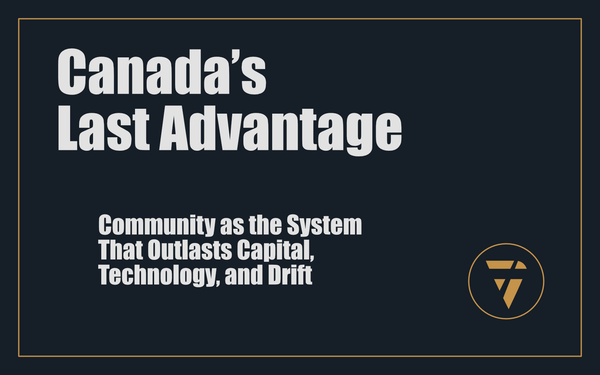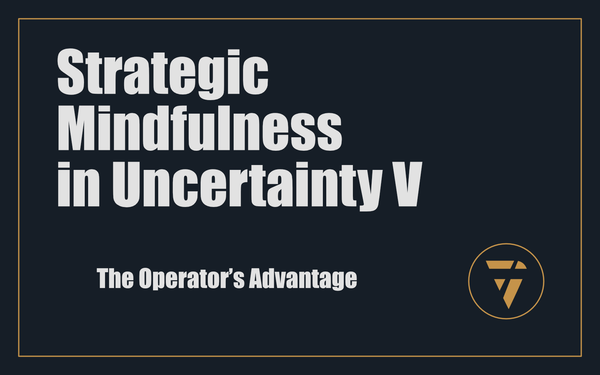Grocery War

Canada Food Systems
The grocery business in Canada was never about groceries. It was about extraction. A few national players learned to squeeze margin from every shelf, every truckload, every square foot of leased space, and every worker who kept the lights on and the lettuce cold. They built an industrial machine and then turned the dial toward shareholders. That's not immoral; it's just how corporate retail evolves when the mandate is to maximise returns.
A lesson someone forcibly taught me, early in my education:
"It's just business."
But there is a second mandate available to anyone willing to pay the entry fee: end extraction, keep the machine, and point the output back at the people who fund the system with their wages and their hunger. A national at-cost grocery is not a charity, not a co-op, and not a temporary price stunt. It's an operating system that converts scale into service rather than dividends. Privately owned. No owner draw. Zero profit by design. Highest wages in the industry. Food sold to households at cost.
First, get clear on the situation. Households are strained. Workers are demoralised. Communities have learned to live with the weight of oligopoly because the alternative has never shown up at national scale. People have tested farmers markets, volunteer shops, and boutique organics. Useful, yes. Scalable, no. Meanwhile, the incumbents captured the invisible part of the iceberg—procurement, distribution, forecasting, and data—then used it to fix the visible part of the iceberg—stores that feel the same in Moose Jaw as they do in Mississauga.
https://www.cbc.ca/news/canada/nova-scotia/non-corporate-grocery-stores-canada-1.7616836
The problem is not “greedflation” as a slogan. The problem is architecture. Profit sits in the blueprint. Even when managers want to behave differently, the machine routes their decisions back to the same endpoint: preserve margin, protect quarterly optics, and keep labour as flexible, replaceable, and inexpensive as the market allows. When prices spike, they rescue the numbers. When wages demand correction, they defend the spread. When communities protest, they gesture at loyalty points and loss-leaders while guarding the core.
The solution is not new ideology. It's new plumbing. Take the exact industrial machine the oligopoly built—its warehouses, data lakes, trucks, replenishment rules, cold chain, slotting fees, and planograms—and strip out the extraction layer. Replace it with a compression engine. Compression is simple: remove the need for profit, then force every efficiency, rebate, and supplier concession to land in only two places—wages, and shelf prices. Now the financial flywheel is not “retained earnings for expansion,” but “operational performance funds labour and lowers household bills.” The incentive becomes service fidelity. The scoreboard is community surplus.
If this were a thesis, it would end here. But words don't feed anyone. Execution is where the model either becomes a public utility in private hands, or dies under its own idealism. So let’s build the operating model the right way—tight, real, and battle-ready.
Governance and ownership come first. Private, single-owner or trust-structured ownership removes board politics, investor cycles, and co-op paralysis. The mission is fixed in a governing instrument that cannot be amended for convenience: zero profit extraction, wage leadership at every operational band, and at-cost pricing to customers. “At cost” is defined, audited, and published. Not “creative cost,” not “adjusted EBITDA fairy tales.” You publish a canonical cost architecture: COGS by category and supplier, inbound freight amortised into unit economics, warehouse handling, shrink, store labour, utilities, occupancy, systems, card fees, and distribution overhead. You apply a standing reserve for contingencies that a real grocery chain requires—cold chain failure, catastrophic spoilage, logistics disruptions—formally held as an operating buffer, not a dividend pool. You reconcile the buffer annually. Anything above the buffer’s target rolls down the stack: first to wage improvements where compression is possible, then to immediate price cuts. There is nothing left. That's the point.
Wages are not a cost problem. They are your performance engine. Pay top of market, across all provinces, for every operational band—warehouse selectors, cashiers, department managers, drivers, store managers, mechanics, refrigeration techs, schedulers. Build clear ladders for skill progression and cross-training. The grocer that treats labour as line-item friction bleeds operational energy through turnover, training loss, and fatigue. The grocer that overpays, trains hard, and keeps shifts stable, creates velocity. Shelves get recovered by people who want to come back tomorrow. Fresh goes to shelf faster. Breakdown rates fall. That is money—real money—that firms usually spend on retention bonuses and overtime painkillers.
Security theatre goes away. You do not criminalise your customers to “deter theft.” You professionalise loss prevention. Replace guards staring at grandmothers with risk-based controls, high-fidelity CCTV where it matters, smart gates that don’t humiliate, and staff density that makes stores feel human. Shrink is an operating constraint, not a moral panic. Workers who feel safe, respected, and well paid watch the floor because they own the outcome. Customers who feel respected stop treating the store as a hostile zone. The hard cases still exist. You handle them without turning the place into a fascist state.
Procurement is where adults need to be in the room. You hire the same buyers incumbents fight over, then hand them a different mandate: price, yes; quality, yes; stability, foremost. Long-dated contracts with growers and processors that stabilise input volatility. Seasonal commitments that put Canadian producers first where they can compete, without performative nationalism that raises household costs. Private label is not an afterthought; it becomes the precision instrument that compresses prices without collapsing quality. You never hide formula changes. You communicate them in-app and in-store, like adults. “We changed this to lower sodium and lower the cost by eight percent. If you hate it, tell us. We'll change it.” That kind of grown-up dialogue creates trust faster than any advertisement.
Distribution is the battlefield the article hinted at, and the incumbents know it. The iceberg below the waterline decides whether someone in Stephenville finds good spinach on a Tuesday at 6 p.m. Route density, cube utilisation, backhaul capture, cross-dock rules, trailer turn time, and DC slotting logic are what feed families. You do not recreate this with vibes. You acquire it, or you hire people who have built it before, and then you do not let finance degrade it for optics. A zero-profit chain can afford redundancy where a margin chain cannot. A spare tractor and an extra night shift picker look like waste until the blizzard hits, the ice road closes, and you are the only store whose perishables arrive on time. Households do not remember your cost of capital. They remember the week you didn’t fold.
Format strategy is not “bigger is better.” Your portfolio holds four forms. First, a national flagship format that proves the thesis in dense markets—full-line grocery, pharmacy adjacency only where it truly serves, and small appliances sparingly. Second, a mid-box everyday that can tuck into suburban and exurban nodes cheaply. Third, a small-town local format that keeps the towns fed without asking them to drive an hour for milk. Fourth, a micro-urban store that competes with corner chains on speed, not catalogue breadth. All four formats share the same back-end brain, the same wages-first values, and the same at-cost discipline. A one-price promise runs through all: the same basket costs the same in Halifax and Prince George once freight and handling are accounted for. You publish the freight adjustments. Pretending a cucumber costs the same to land everywhere insults the public; explaining why it differs by six cents earns you grace.
Pricing and promotion cannot mimic the incumbent drug. You don't create fake savings with high-low theatre. You don't run a shell game of points whose value declines when the CFO is nervous. You run stable basket pricing, with true seasonal lifts where harvests spike volume. You collapse the tail of slow-moving SKUs, freeing capital and shelf for depth in what communities actually buy. You eliminate slotting fees as a profit centre. If a fee exists, it offsets the cost to reset a planogram or run a DC trial. You publish that fee logic, too. CPGs will scream at first. Then they will understand that predictable, transparent rules beat opaque negotiations that depend on who bought lunch.
Technology is the nervous system. Do not buy toys. Buy reliability. Your forecasting must live at the intersection of history, weather, event calendars, and local nuance in a store manager’s head. Build tools that respect the manager’s judgement rather than replace it. The best operators have always outperformed the machine because they know who's getting paid this Friday, and which crews will buy ribs if the sun appears. Let the system bring them the probabilities. Let them override with reasons. Track the overrides. Train the system. The human stays in front.
Payments matter. You pay the interchange tax like everyone else, but you design your own basic debit rails for the in-app ecosystem to make micro-marginal savings that flow straight down to prices. No loyalty candy. No casino noise. A simple ledger customers can see: “We saved $0.19 in fees on this basket. It’s in your total.” This is how trust is built: penny by penny, explained and repeated.
Regulation and politics will become a theatre of accusation when you win. Competitors will call it “predatory.” They will pretend at-cost is a trick. You will be audited more than you thought possible. Plan for it. Make your audit package a public resource. Invite a rotating panel of independent accountants and consumer advocates to review your cost rules annually. Publish their notes, including where they forced you to change a definition. Your only defence against a PR war is radical clarity and the discipline to never play cute with numbers. When the Minister calls, you have the documents ready.
Workforce development is where the culture either stays adult or slides backward. You operate stores as civil places with grown-up expectations. You put paid time into skills—food safety, fresh-cut mastery, bakery craft, forklift elegance, refrigeration basics. You pay more for certified capability, not tenure alone. You run real scheduling dignity—two weeks locked, no whiplash unless snow or flood requires it. And when the world breaks, you do not hide the overtime behind temp agencies that treat workers like inventory. You ask staff to step up, you pay them properly, and you publicly thank the crews that kept families fed when roads closed.
Community capital is not a donation program. It's a structural promise. You commit a percentage of total operating hours per store to community use—training sessions, nutrition workshops, local producer “show and tell,” and after-hours pop-ups where small makers can sell at zero rent with your point-of-sale support. You don't sponsor jerseys for branding. You fund competence. Teach a sixteen-year-old how to load a trailer safely, and you have built more prosperity than any cheque to a gala.
“How do you pay for all this?” is the wrong question. The right question is, “Where did the money go before?” It went to profit extraction, dividend policies, buybacks, and head office optics. Take that same money, reassign it to wages and price compression, and the public realises that the grocery chain was never short of cash. It was short of purpose.
“But can it scale?” Yes, because the industrial machine you need already exists. The point is not to build a fragile imitation. The point is to acquire a functioning network and flip the mandate. Starting from scratch and vowing to out-logistic Galen is romantic nonsense. Start where the freight lanes already sing.
“But won’t competitors cut prices to starve you?” They can try. A margin-bound chain can run local price wars for quarters. It cannot turn off profit across the whole network for years without burning its capital markets house to the ground. You will be attacked. You will be accused. You will also be the grocer with the full bakery staff at 6 a.m. because your people are the best-paid in town. You will be the one with a DC that kept bananas flowing during a rail disruption because you budgeted redundancy as a duty instead of a sin. Over time, families vote with their carts.
“But isn’t a co-op more democratic?” For a neighbourhood, maybe. For a nation, it becomes governance molasses. You are not trying to run a parliament. You are trying to run the cold chain for millions of people without fail. Private ownership—singular, accountable, and bound by a non-extraction charter—delivers speed, clarity, and a single call standards slip. If democracy is your goal, do it in civic life. If feeding the country is your job, remove the committees and ship on time.
The small-town proof matters. A national at-cost grocer is worthless if it only works in Toronto. The local format should be the jewel, not the neglected cousin. Lean assortments that reflect how people actually cook, not how category managers theorise. Good meat, good bread, honest staples. A manager who knows the names of the welders, the school bus drivers, and the nurses who swing by after shift. Trucks that hit the right time windows so a family can shop after work without staring at empty shelves. If it doesn't work in Fort St. John, it does not work.
Now, the lever that makes this unassailable: acquisition and conversion. Buying a mid-tier national competitor compresses a decade of “build” into a single decisive act. You inherit the warehouses, the workforce, the lanes, the IT stack, and the lease portfolio. On day one, you remove the extraction layer and install the at-cost charter. Wages move up immediately to top of market. Shelf prices move down immediately by the full value of eliminated profit, less the prudently published operating buffer. Your P&L stops being a theatre and becomes an instrument panel. You instruct procurement to convert trade spend and rebates into shelf compression rather than head-office wins. You instruct finance that there will be no cosmetic victories—no transfer-pricing games, no head-office management fees to mask extraction, no loyalty point liabilities used to goose optics. You instruct HR that the employer brand is now the product.
Competitors will panic. They will copy your language and fail to copy your numbers. They will invent “price locks” and “promise baskets” that require fine print. You will not respond with marketing. You will respond with receipts. A public monthly cost ledger. A wage table anyone can understand. An explanation when bananas went up two cents because a ship sat off a port for three days. Grown-ups to grown-ups.
Converting a mid-tier competitor also fixes the two objections that plague every optimistic reformer. First, scale and logistics: solved on day one. Second, supplier power: solved on day one. You don't enter the room as a noble startup. You enter as a top-three buyer who has changed the terms of engagement. Manufacturers will respect the volume and learn to admire the clarity. Many will prefer it. Predictable, audited, at-cost pass-through beats opaque negotiations that swing on end-cap theatre.
The result is market control without monopoly tactics. You do not need to own eighty percent of the market to direct it. You need to set a standard that consumers trust, workers crave, and suppliers can plan around. When your stores become the yardstick, competitors must choose between honouring the standard or explaining to households why their weekly shop costs more. That is not a PR fight they want.
A final word on consequence. If this model is executed with softness, it will invite ridicule and collapse. If it's executed with severity, clarity, and respect, it will realign a sector that touches every kitchen in the country. Communities will feel the difference in their wallets. Workers will feel the difference in their backs and their calendars. Suppliers will feel the difference in the stability of their order books. And the people who used to collect the spread will look for a new playground. That is not cruelty. That is rebalancing.
This is not theory. It's a blueprint that requires only the will to purchase the machine and the discipline to refuse extraction. Fund it. Acquire a mid-tier national competitor. Convert it without apology. Publish the rules. Pay people properly. Sell food at cost. It will work on a small-town corner where the highway bends, and it will work at a flagship in a dense city where families sprint after work. It will dominate on performance because the incentive stack finally points where it should—to the customer and the employee, not to the pockets above them.
The next lever is simple: identify the acquisition target (sup, Sobey's), assemble the conversion charter, and brief procurement, distribution, and HR on day-one instructions.
This is what I’m working on. Tell me what you think, I enjoy the conversation! Subscribe and follow the work in real time.
Thanks!
B

Groceries don’t need profit.
Every margin they take is money pulled from your fridge and your paycheque.
PS -






